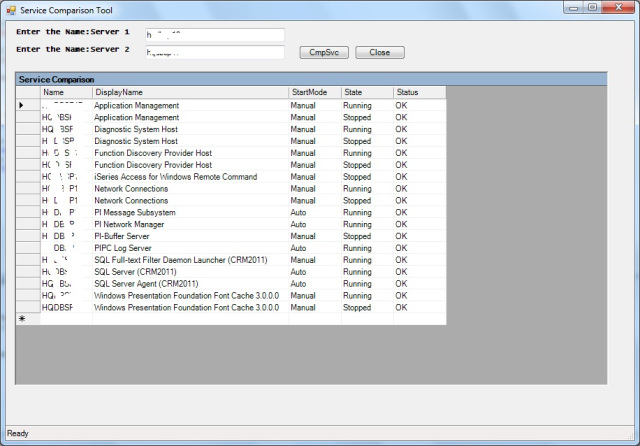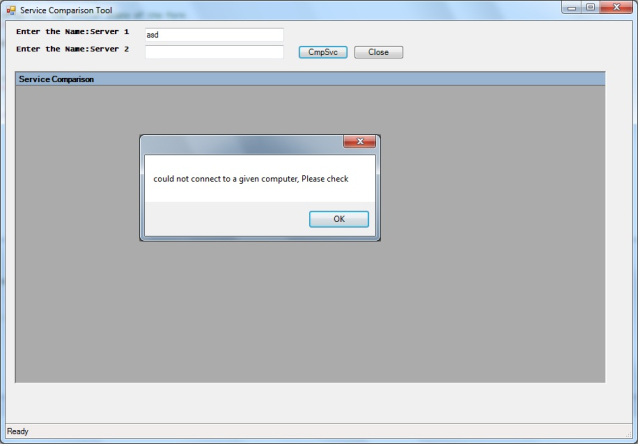Service Comparison GUI Tool does comparison of all the services of any given two servers. The output is a grid view and sorting can be done on a required columns. The result is a combination of unique services and the same services are of different state.
Copy and paste the below code on Powershell-ISE for better execution.
Tool Details :The layout details are as follows
Download the code - ServiceComparisonTool
Code-
function Compare-Service
{
function OnApplicationLoad {
return $true
}
function OnApplicationExit {
#Note: This function runs after the form is closed
#TODO: Add custom code to clean up and unload snapins when the application exits
}
#endregion Application Functions
#----------------------------------------------
# Generated Form Function
#----------------------------------------------
function Call-SystemInformation_pff {
#----------------------------------------------
#region Import the Assemblies
#----------------------------------------------
[void][reflection.assembly]::Load("System.Windows.Forms, Version=2.0.0.0, Culture=neutral, PublicKeyToken=b77a5c561934e089")
[void][reflection.assembly]::Load("System.Drawing, Version=2.0.0.0, Culture=neutral, PublicKeyToken=b03f5f7f11d50a3a")
[void][reflection.assembly]::Load("mscorlib, Version=2.0.0.0, Culture=neutral, PublicKeyToken=b77a5c561934e089")
[void][Reflection.Assembly]::LoadWithPartialName("System.Windows.Forms")
[void][Reflection.Assembly]::LoadWithPartialName("System.Windows.Forms.DataVisualization")
#get-pssnapin -Registered -ErrorAction silentlycontinue
#endregion Import Assemblies
#----------------------------------------------
#region Generated Form Objects
#----------------------------------------------
[System.Windows.Forms.Application]::EnableVisualStyles()
$form1 = New-Object System.Windows.Forms.Form
$btnRefresh = New-Object System.Windows.Forms.Button
$btngetdata=New-Object System.Windows.Forms.Button
$rtbPerfData = New-Object System.Windows.Forms.RichTextBox
#$pictureBox1 = New-Object System.Windows.Forms.PictureBox
$lblServicePack = New-Object System.Windows.Forms.Label
$lblDBName= New-Object System.Windows.Forms.Label
$lblOS = New-Object System.Windows.Forms.Label
$lblExpire = New-Object System.Windows.Forms.Label
$statusBar1 = New-Object System.Windows.Forms.StatusBar
$btnClose = New-Object System.Windows.Forms.Button
#$comboServers = New-Object System.Windows.Forms.ComboBox
$InitialFormWindowState = New-Object System.Windows.Forms.FormWindowState
$txtComputerName1 = New-Object System.Windows.Forms.TextBox
$txtComputerName2 = New-Object System.Windows.Forms.TextBox
$dataGrid1 = New-Object System.Windows.Forms.DataGrid
$Chart = New-object System.Windows.Forms.DataVisualization.Charting.Chart
#$dataGrid1 = new-object System.windows.forms.DataGridView
#endregion Generated Form Objects
#----------------------------------------------
# User Generated Script
#----------------------------------------------
Function Compare-Service
{
param(
[Parameter(Mandatory=$true)] [string]$Computer1,
[Parameter(Mandatory=$true)] [string]$Computer2
)
$Object =@()
try
{
$ServicesOnComputer1 = Get-WMIObject -ComputerName $Computer1 -Class Win32_service -ErrorAction Stop
}
Catch [Exception]
{
[System.Windows.Forms.MessageBox]::Show("The $Computer1 host entered does not exist or cannot be contacted. Please try again!!!!");
}
try
{
$ServicesOnComputer2 = Get-WMIObject -ComputerName $Computer2 -Class Win32_service -ErrorAction Stop
}
Catch [Exception]
{
[System.Windows.Forms.MessageBox]::Show("The $Computer2 host entered does not exist or cannot be contacted. Please try again");
}
$d=Compare-Object -ReferenceObject $ServicesOnComputer1 -DifferenceObject $ServicesOnComputer2 -Property Name, StartMode, State, Status -PassThru `
| Sort-Object DisplayName, SystemName | Select-Object SystemName, DisplayName, StartMode, State, Status
foreach($Ser in $D)
{
$SystemName = $Ser.SystemName
$DisplayName = $Ser.DisplayName
$StartMode =$Ser.StartMode
$State = $Ser.State
$Status =$Ser.Status
$Object += New-Object PSObject -Property @{Name= $SystemName.ToUpper();DisplayName= $DisplayName;StartMode=$StartMode;State=$State;Status=$Status;}
}
$dt = new-Object Data.datatable
$First = $true
foreach ($item in $Object){
$DR = $DT.NewRow()
$Item.PsObject.get_properties() | foreach {
If ($first) {
$Col = new-object Data.DataColumn
$Col.ColumnName = $_.Name.ToString()
$DT.Columns.Add($Col) }
if ($_.value -eq $null) {
$DR.Item($_.Name) = "[empty]"
}
ElseIf ($_.IsArray) {
$DR.Item($_.Name) =[string]::Join($_.value ,";")
}
Else {
$DR.Item($_.Name) = $_.value
}
}
$DT.Rows.Add($DR)
# $array.AddRange($DR)
$First = $false
}
$dataGrid1.DataSource = $dt
}
$Close={
$form1.close()
}
$GetData={
if((Test-Connection -ComputerName $txtComputerName1.text -Count 1 -ea 0) -and (Test-Connection -ComputerName $txtComputerName2.text -Count 1 -ea 0))
{
$statusBar1.text="Getting the Service Related Information...Please wait"
Compare-Service -Computer1 $txtComputerName1.text -Computer2 $txtComputerName2.text
}
ELSE
{
[void][System.Windows.Forms.MessageBox]::Show("could not connect to a given computer, Please check")
$statusBar1.text="Computer Name is Invalid.please check"
}
# $rtbPerfData.text=$data.Trim()
$txtComputerName1.usewaitcursor=$False
$errorActionPreference="Continue"
$statusBar1.Text="Ready"
}
# --End User Generated Script--
#----------------------------------------------
# Generated Events
#----------------------------------------------
$Form_StateCorrection_Load=
{
#Correct the initial state of the form to prevent the .Net maximized form issue
$form1.WindowState = $InitialFormWindowState
}
#----------------------------------------------
#region Generated Form Code
#----------------------------------------------
#
# form1
#
$form1.Controls.Add($btnRefresh)
#$form1.Controls.Add($rtbPerfData)
#$form1.Controls.Add($pictureBox1)
$form1.Controls.Add($lblServicePack)
$form1.Controls.Add($lblOS)
$form1.Controls.Add($lblDBName)
$form1.Controls.Add($statusBar1)
$form1.Controls.Add($btnClose)
$form1.Controls.Add($txtComputerName1)
$Form1.controls.add($Chart)
$Form1.controls.add($txtComputerName2)
$Form1.controls.add($lblExpire)
$form1.ClientSize = New-Object System.Drawing.Size(900,600)
$form1.DataBindings.DefaultDataSourceUpdateMode = [System.Windows.Forms.DataSourceUpdateMode]::OnValidation
#$form1.FormBorderStyle = [System.Windows.Forms.FormBorderStyle]::SizableToolWindow
$form1.Name = "form1"
$form1.Text = "Service Comparison Tool "
$form1.add_Load($PopulateList)
# create chart object
$System_Drawing_Size = New-Object System.Drawing.Size
$System_Drawing_Size.Width = 850
$System_Drawing_Size.Height = 450
$dataGrid1.Size = $System_Drawing_Size
$dataGrid1.DataBindings.DefaultDataSourceUpdateMode = 0
$dataGrid1.HeaderForeColor = [System.Drawing.Color]::FromArgb(255,0,0,0)
$dataGrid1.Name = "dataGrid1"
$dataGrid1.DataMember = ""
$dataGrid1.TabIndex = 0
$System_Drawing_Point = New-Object System.Drawing.Point
$System_Drawing_Point.X =13
$System_Drawing_Point.Y = 72
$dataGrid1.Location = $System_Drawing_Point
$Chart.visible=$FALSE
$form1.Controls.Add($dataGrid1)
$dataGrid1.CaptionText='Service Comparison'
#
# btnRefresh
#
$btnRefresh.DataBindings.DefaultDataSourceUpdateMode = [System.Windows.Forms.DataSourceUpdateMode]::OnValidation
$btnRefresh.Enabled = $TRUE
$btnRefresh.Location = New-Object System.Drawing.Point(420,35)
$btnRefresh.Name = "btnRefresh"
$btnRefresh.Size = New-Object System.Drawing.Size(72,20)
$btnRefresh.TabIndex = 7
$btnRefresh.Text = "CmpSvc"
$btnRefresh.UseVisualStyleBackColor = $True
$btnRefresh.add_Click($GetData)
#
#
# btnClose
#
$btnClose.DataBindings.DefaultDataSourceUpdateMode = [System.Windows.Forms.DataSourceUpdateMode]::OnValidation
$btngetdata.Enabled = $TRUE
$btnClose.Location = New-Object System.Drawing.Point(500,35)
$btnClose.Name = "btnClose"
$btnClose.Size = New-Object System.Drawing.Size(72,20)
$btnClose.TabIndex = 3
$btnClose.Text = "Close"
$btnClose.UseVisualStyleBackColor = $True
$btnClose.add_Click($Close)
#
# lblDBName
#
$lblDBName.DataBindings.DefaultDataSourceUpdateMode = [System.Windows.Forms.DataSourceUpdateMode]::OnValidation
$lblDBName.Font = New-Object System.Drawing.Font("Lucida Console",8.25,1,3,1)
$lblDBName.Location = New-Object System.Drawing.Point(13,10)
$lblDBName.Name = "lblDBName"
$lblDBName.Size = New-Object System.Drawing.Size(178,23)
$lblDBName.TabIndex = 0
$lblDBName.Text = "Enter the Name:Server 1 "
$lblDBName.Visible = $TRUE
#
#$txtComputerName1.text
#txtComputerName1
$txtComputerName1.DataBindings.DefaultDataSourceUpdateMode = [System.Windows.Forms.DataSourceUpdateMode]::OnValidation
$txtComputerName1.Location = New-Object System.Drawing.Point(200, 10)
$txtComputerName1.Name = "txtComputerName1"
$txtComputerName1.TabIndex = 1
$txtComputerName1.Size = New-Object System.Drawing.Size(200,70)
$txtComputerName1.visible=$TRUE
#
#
# lblExpire
#
$lblExpire.DataBindings.DefaultDataSourceUpdateMode = [System.Windows.Forms.DataSourceUpdateMode]::OnValidation
$lblExpire.Font = New-Object System.Drawing.Font("Lucida Console",8.25,1,3,1)
$lblExpire.Location = New-Object System.Drawing.Point(13,35)
$lblExpire.Name = "lblExpire"
$lblExpire.Size = New-Object System.Drawing.Size(178,23)
$lblExpire.TabIndex = 0
$lblExpire.Text = "Enter the Name:Server 2 "
$lblExpire.Visible = $TRUE
#
#$txtComputerName2.text
#txtComputerName2
$txtComputerName2.DataBindings.DefaultDataSourceUpdateMode = [System.Windows.Forms.DataSourceUpdateMode]::OnValidation
$txtComputerName2.Location = New-Object System.Drawing.Point(200, 35)
$txtComputerName2.Name = "txtComputerName2"
$txtComputerName2.TabIndex = 1
$txtComputerName2.Size = New-Object System.Drawing.Size(200,70)
$txtComputerName2.visible=$TRUE
#
# lblServicePack
#
$lblServicePack.DataBindings.DefaultDataSourceUpdateMode = [System.Windows.Forms.DataSourceUpdateMode]::OnValidation
$lblServicePack.Font = New-Object System.Drawing.Font("Lucida Console",8.25,1,3,1)
$lblServicePack.Location = New-Object System.Drawing.Point(13,100)
$lblServicePack.Name = "lblServicePack"
$lblServicePack.Size = New-Object System.Drawing.Size(278,23)
$lblServicePack.TabIndex = 0
$lblServicePack.Text = "ServicePack"
$lblServicePack.Visible = $False
#
# lblOS
#
$lblOS.DataBindings.DefaultDataSourceUpdateMode = [System.Windows.Forms.DataSourceUpdateMode]::OnValidation
$lblOS.Font = New-Object System.Drawing.Font("Lucida Console",8.25,1,3,1)
$lblOS.Location = New-Object System.Drawing.Point(12,77)
$lblOS.Name = "lblOS"
$lblOS.Size = New-Object System.Drawing.Size(278,23)
$lblOS.TabIndex = 2
$lblOS.Text = "User Information"
$lblOS.Visible = $False
#
# statusBar1
#
$statusBar1.DataBindings.DefaultDataSourceUpdateMode = [System.Windows.Forms.DataSourceUpdateMode]::OnValidation
$statusBar1.Location = New-Object System.Drawing.Point(0,365)
$statusBar1.Name = "statusBar1"
$statusBar1.Size = New-Object System.Drawing.Size(390,22)
$statusBar1.TabIndex = 5
$statusBar1.Text = "statusBar1"
#
#>
$rtbPerfData.BackColor = [System.Drawing.Color]::FromArgb(255,255,255,255)
$rtbPerfData.BorderStyle = [System.Windows.Forms.BorderStyle]::None
$rtbPerfData.DataBindings.DefaultDataSourceUpdateMode = [System.Windows.Forms.DataSourceUpdateMode]::OnValidation
$rtbPerfData.Font = New-Object System.Drawing.Font("Lucida Console",8.25,0,3,1)
$rtbPerfData.Location = New-Object System.Drawing.Point(13,120)
$rtbPerfData.Name = "rtbPerfData"
$rtbPerfData.Size = New-Object System.Drawing.Size(450,200)
$rtbPerfData.TabIndex = 6
$rtbPerfData.Text = ""
#Save the initial state of the form
$InitialFormWindowState = $form1.WindowState
#Init the OnLoad event to correct the initial state of the form
$form1.add_Load($Form_StateCorrection_Load)
#Show the Form
return $form1.ShowDialog()
} #End Function
#Call OnApplicationLoad to initialize
if(OnApplicationLoad -eq $true)
{
#Create the form
Call-SystemInformation_pff | Out-Null
#Perform cleanup
OnApplicationExit
}
}
Compare-Service 



